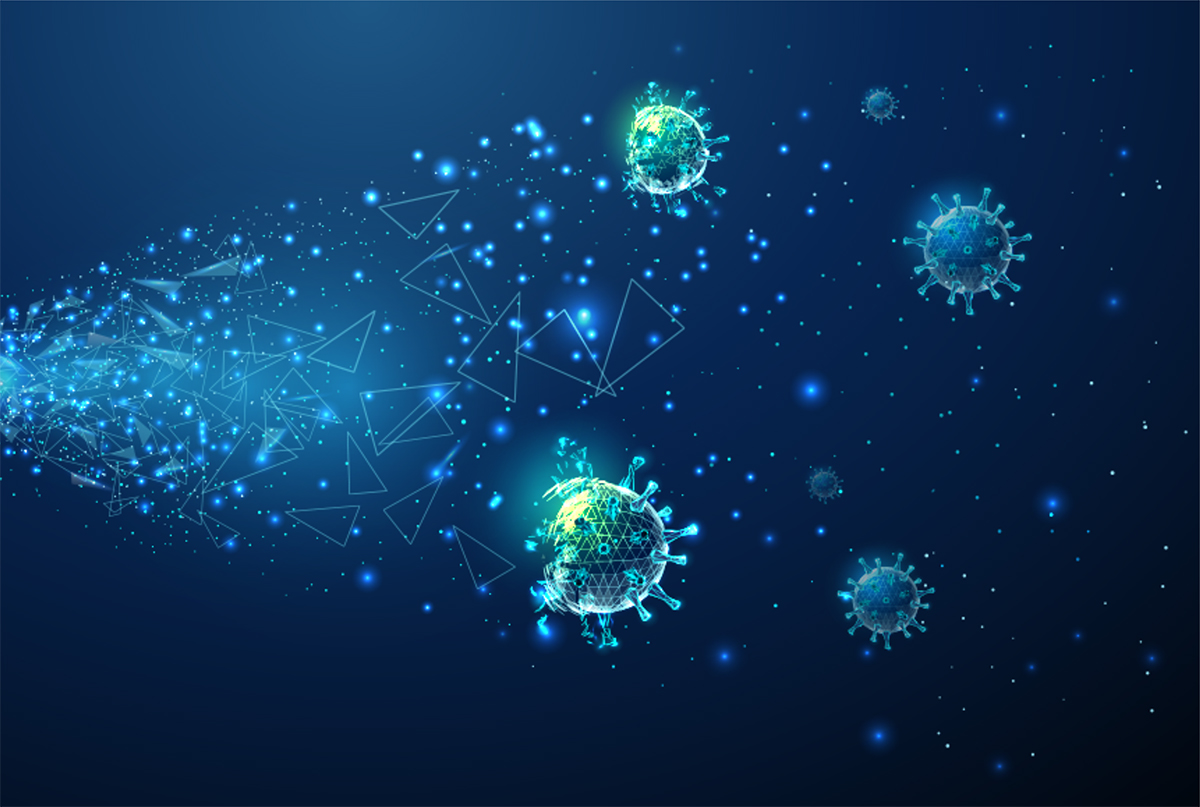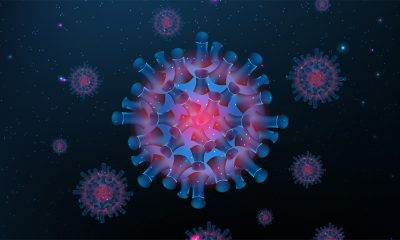What is a UV germicidal light
Disinfection lights and germicidal lamps produce ultraviolet (UV) radiation that can activate destructive photochemical reactions and ultimately lead to inactivation of bacteria and viruses. UV is a form of electromagnetic radiation with a wavelength shorter than the visible rays and longer than the X-rays, ranging from 100 to 400 nanometers. The electromagnetic spectrum of ultraviolet radiation can be subdivided into a number of ranges, including UV-A (long-wave) from 315 to 400 nm, UV-B (medium-wave) from 280 to 315 nm, and UV-C (short-wave) from 100 to 280 nm. UV radiation in wavelengths of 100 – 200 nm is commonly called vacuum UV as the photons are absorbed in the ionosphere and by atmospheric oxygen. While UV-C light from 100 to 280 nm is viricidal, bactericidal and fungicidal, the range of UV of particular effectiveness and usability for disinfection and sterilization lies in the spectral band from approximately 200 to 280 nm. Common sources of UV-C in commercial applications are generally engineered to deliver a peak emission wavelength within this band.
Fundamentals of UV disinfection
UV light exerts its disinfecting power through the influence of high energy photons. The high energy from short wavelength UV-C photons can penetrate the cell wall and/or protoplasm of the pathogens and split chemical bonds between nucleic acids in the deoxyribonucleic acid (DNA) or ribonucleic acid (RNA) molecules of the bacteria, viruses, mold, parasites and fungi, thus preventing these microorganisms from infecting and reproducing. The photochemical reaction leads to pyramidine dimerization within DNA/RNA, disulphide bridge breakdown in proteins and protein-DNA cross-linking. Pyrimidine dimerization, which is the dominant UV damage, causes two adjacent thymines in DNA or uracils in RNA to produce a photodimeric lesion. The dimerization along with the DNA/RNA strand changes the molecular structure and disrupts of cell metabolism and other biological functions. The intense radiation overwhelms the repair mechanism and the DNA/RNA can no longer duplicate during the cell-division process. UV light has been shown to disrupt disulphide bridges which are an important component of the secondary and tertiary structure in proteins. In some pathogens, especially viruses, a protein-DNA/RNA linkage can be established between a protein and a DNA strand when a protein absorbs UV light, which eventually damages the cellular structures. DNA and RNA molecules are most sensitive to short wavelength radiation between 260 nm and 265 nm, while proteins have a peak absorption of UV-C photons at about 280 nm.
Germicidal lighting applications
Disinfection lights and germicidal lamps are used for air, surface, object and water disinfection in industrial, commercial, medical, public and residential environments. Germicidal UV (GUV) radiation sees its increasing applications in in enclosed spaces where trapped or recirculated indoor air may contain microorganisms and viruses. These contaminants and the associated airborne infections can be considerably reduced by installing lights near coils and drain pans of air conditioning systems or in the upper part of a room, where it does not reach people directly, to destroy floating particles in the air. Ultraviolet germicidal irradiation (UVGI) systems are used to disinfect the upper air layers within rooms. Through the mechanism of natural or forced air convection, air flows from the lower areas of a room where people are circulated to the upper areas of a room and get disinfected as they pass through the UV-C disinfection zone. Air disinfection with open UV-C fixtures that radiate UV-C directly without shielding are mostly used in spaces where access of occupants is controlled. The use of GUV radiation for surface disinfection within an array of facilities such as schools, retail outlets, clinics, operating rooms or food processing plants is gaining increasing popularity due to its ease of use, short dosage times, and effectiveness of microorganism inactivation. UV-C disinfection chambers and portable disinfection lights are designed for the disinfection of objects that are shared between people. UV disinfection technology also finds its wide applications in drinking water, groundwater and wastewater disinfection.
Fighting COVID-19
Germicidal UV radiation is under the spotlight as the COVID-19 pandemic spurred the demand for disinfection equipment to combat the spread of coronaviruses. Coronavirus disease 2019 (COVID-19) is an infectious disease caused by a newly discovered coronavirus named SARS-CoV-2. COVID-19 is mainly transmitted via the respiratory route when people inhale droplets and particle exhaled by infected people as they breathe, talk, cough, sneeze, or sing. COVID-19 spreads when droplets and particles that contain the virus land on eyes, noses, or mouth. In some circumstances, surfaces that are touched infected people may be contaminated. Coronaviruses (including SARS-CoV-1, MERS-CoV, and SARS-CoV-2) are single-stranded RNA viruses encapsulated by a host-derived lipid bilayer, studded with proteins that protrude like crown-like spikes. These viruses are significantly less resistant against the photochemical effects of UV-C irradiation than double-stranded viruses due to the lower stability. With an appropriate spectrum and dose, the SARS-CoV-2 virus and coronavirus’s variants can be completely inactivated.
Mercury vapor lamps
Germicidal ultraviolet light can be produced from various types of light source. Mercury vapor lamps are most commercially viable source of UV-C light. A mercury vapor lamp is a gas discharge lamp that produces light by passing an electric arc through vaporized mercury within a clear quartz envelope. This family of GUV sources includes low-pressure mercury (LPM), medium-pressure mercury (MPM), and high-pressure mercury (HPM) lamps. The most efficient source for germicidal applications is the low-pressure mercury lamp which has a wall plug efficiency (WPE) exceeding 25%. About 90% of the emitted light from low-pressure mercury lamps is of the 253.7 nm wavelength. Medium-pressure and high-pressure mercury lamps deliver a much higher UVC output than low-pressure mercury lamps, but at much lower efficacies. UV-C radiation can be generated from pulsed xenon lamps which are a type of gas discharge lamp and operate by passing electricity through ionized xenon gas under high pressure. The high intensity discharge source can produce high intensity radiation in a single pulse, with peak germicidal wavelengths around 275 nm. A third type of UV source is the excimer lamp which can provide 222 nm narrow-band radiation. Although traditional UV lamps are the backbone of UV disinfection, they have a number of disadvantages that limit their prospect. These disadvantages include fixed spectrum, long warm-up/start-up time, radiant heating, large size, short lifespan, poor resistance to mechanical shocks or vibrations due to the use of fragile glass envelopes.
LED disinfection light
The latest trend of GUV development is to make use of solid state lighting based on light emitting diode (LED) technology. The LED technology platform allows for precise control of the spectral power distribution (SPD). An LED disinfection light can be tailored to produce a spectrum optimized for the function of the light. The ability to deliver targeted wavelengths makes it possible to achieve maximal effectiveness in inactivating bacteria and viruses of various types at significantly lower levels of UV exposure. Unwanted wavelengths can also be filtered out of the spectrum so as to eliminate irradiance hazards. Traditional UV lamps can produce ozone-forming radiation; hence precautions have to be taken since ozone inhalation at higher concentrations is considered a health risk. These lamps also produce a large amount of heat in the form of infrared (IR) energy, which can cause thermal damages. UV-C LEDs are completely IR- and ozone-free. LEDs provide instant light and fully dimmable output, making it a breeze to optimize and adjust the required exposures. The small size and optical directionality of LEDs also allow the use of secondary optics to provide tight beam control for precise delivery of light to surface requiring disinfection. The solid state durability of LEDs translates to greater resistance to shock and vibration.
UV-C LED
UV-C LEDs are typically fabricated from the AlGaN (aluminum gallium nitride) material system. These LEDs can be engineered to emit a very narrow wavelength band of radiation from 210 nm to 360 nm by carefully manipulating the semiconductor bandgap. AlGaN LEDs, however, are challenged to deliver a decent WPE. A high rate of non-radiative electron-hole recombination and a high density of thread dislocations due to heteroepitaxial growth on foreign substrates result in an external quantum efficiency (EQE) of less than 10%. An LED disinfection light requires the use of compatible LED drivers and thermal management systems to ensure that the LEDs operate under specified ranges for junction temperature and electrical power.








Loading...